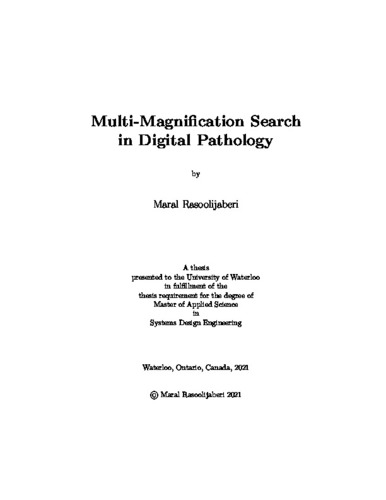| dc.contributor.author | Rasoolijaberi, Maral | |
| dc.date.accessioned | 2021-09-21 15:45:06 (GMT) | |
| dc.date.available | 2021-09-21 15:45:06 (GMT) | |
| dc.date.issued | 2021-09-21 | |
| dc.date.submitted | 2021-08-29 | |
| dc.identifier.uri | http://hdl.handle.net/10012/17460 | |
| dc.description.abstract | This research study investigates the effect of magnification on content-based image search in digital pathology archives and proposes to use multi-magnification image representation. Image search in large archives of digital pathology slides provides researchers and medical professionals with an opportunity to match records of current and past patients and learn from evidently diagnosed and treated cases. When working with microscopes, pathologists switch between different magnification levels while examining tissue specimens to find and evaluate various morphological features. Inspired by the conventional pathology workflow, this thesis investigates several magnification levels in digital pathology and their combinations to minimize the gap between AI-enabled image search methods and clinical settings. This thesis suggests two approaches for combining magnification levels and compares their performance. The first approach obtains a single-vector deep feature representation for a WSI, whereas the second approach works with a multi-vector deep feature representation. The proposed content-based searching framework does not rely on any pixel-level annotation and potentially applies to millions of unlabelled (raw) WSIs. This thesis proposes using binary masks generated by U-Net as the primary step of patch preparation to locating tissue regions in a WSI. As a part of this thesis, a multi-magnification dataset of histopathology patches is created by applying the proposed patch preparation method on more than 8,000 WSIs of TCGA repository.
The performance of both MMS methods is evaluated by investigating the top three most similar WSIs to a query WSI found by the search. The search is considered successful if two out of three matched cases have the same malignancy subtype as the query WSI. Experimental search results across tumors of several anatomical sites at different magnification levels, i.e., 20×, 10×, and 5× magnifications and their combinations, are reported in this thesis.
The experiments verify that cell-level information at the highest magnification is essential for searching for diagnostic purposes. In contrast, low-magnification information may improve this assessment depending on the tumor type. Both proposed search methods generally performed more accurately at 20× magnification or the combination of the 20× magnification with 10×, 5×, or both. The multi-magnification searching approach achieved up to 11% increase in F1-score for searching among some tumor types, including the urinary tract and brain tumor subtypes compared to the single-magnification image search. | en |
| dc.language.iso | en | en |
| dc.publisher | University of Waterloo | en |
| dc.title | Multi-Magnification Search in Digital Pathology | en |
| dc.type | Master Thesis | en |
| dc.pending | false | |
| uws-etd.degree.department | Systems Design Engineering | en |
| uws-etd.degree.discipline | System Design Engineering | en |
| uws-etd.degree.grantor | University of Waterloo | en |
| uws-etd.degree | Master of Applied Science | en |
| uws-etd.embargo.terms | 0 | en |
| uws.contributor.advisor | Tizhoosh, Hamid | |
| uws.contributor.affiliation1 | Faculty of Engineering | en |
| uws.published.city | Waterloo | en |
| uws.published.country | Canada | en |
| uws.published.province | Ontario | en |
| uws.typeOfResource | Text | en |
| uws.peerReviewStatus | Unreviewed | en |
| uws.scholarLevel | Graduate | en |

